Impact of Infection Control Training on HAIs in Canadian Hospitals
VerifiedAdded on 2023/06/05
|20
|4108
|69
AI Summary
This research proposal investigates hospital-acquired infections (HAIs) in Canada, where rates have increased by 11.7%. It highlights a lack of knowledge among nursing professionals regarding HAIs, leading to higher mortality, morbidity, costs, and hospital stays. The research aims to determine the role of education in preventing and controlling infection, emphasizing compliance with precautions and its impact on reducing infection rates. Using a mixed-method approach, the study will assess the knowledge, awareness, and compliance of 50 healthcare workers through quantitative and qualitative analyses. The proposal outlines the research problem, aims, objectives, questions, methods, ethical considerations, sample, timeline, resources, and key literature sources, emphasizing the need for improved training to enhance infection control practices among healthcare professionals in Canadian hospitals. Desklib provides access to this and other solved assignments for students.
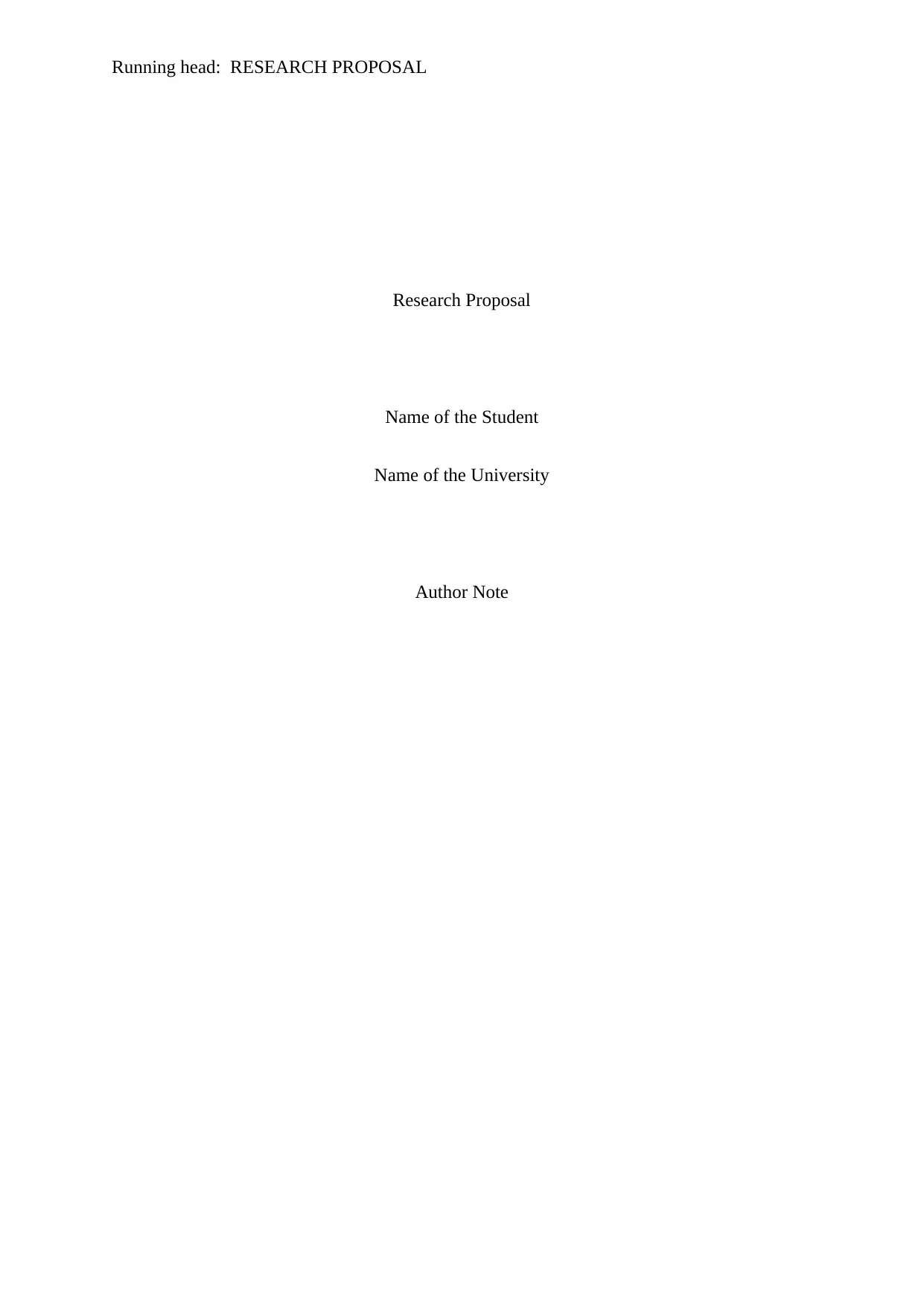
Running head: RESEARCH PROPOSAL
Research Proposal
Name of the Student
Name of the University
Author Note
Research Proposal
Name of the Student
Name of the University
Author Note
Paraphrase This Document
Need a fresh take? Get an instant paraphrase of this document with our AI Paraphraser
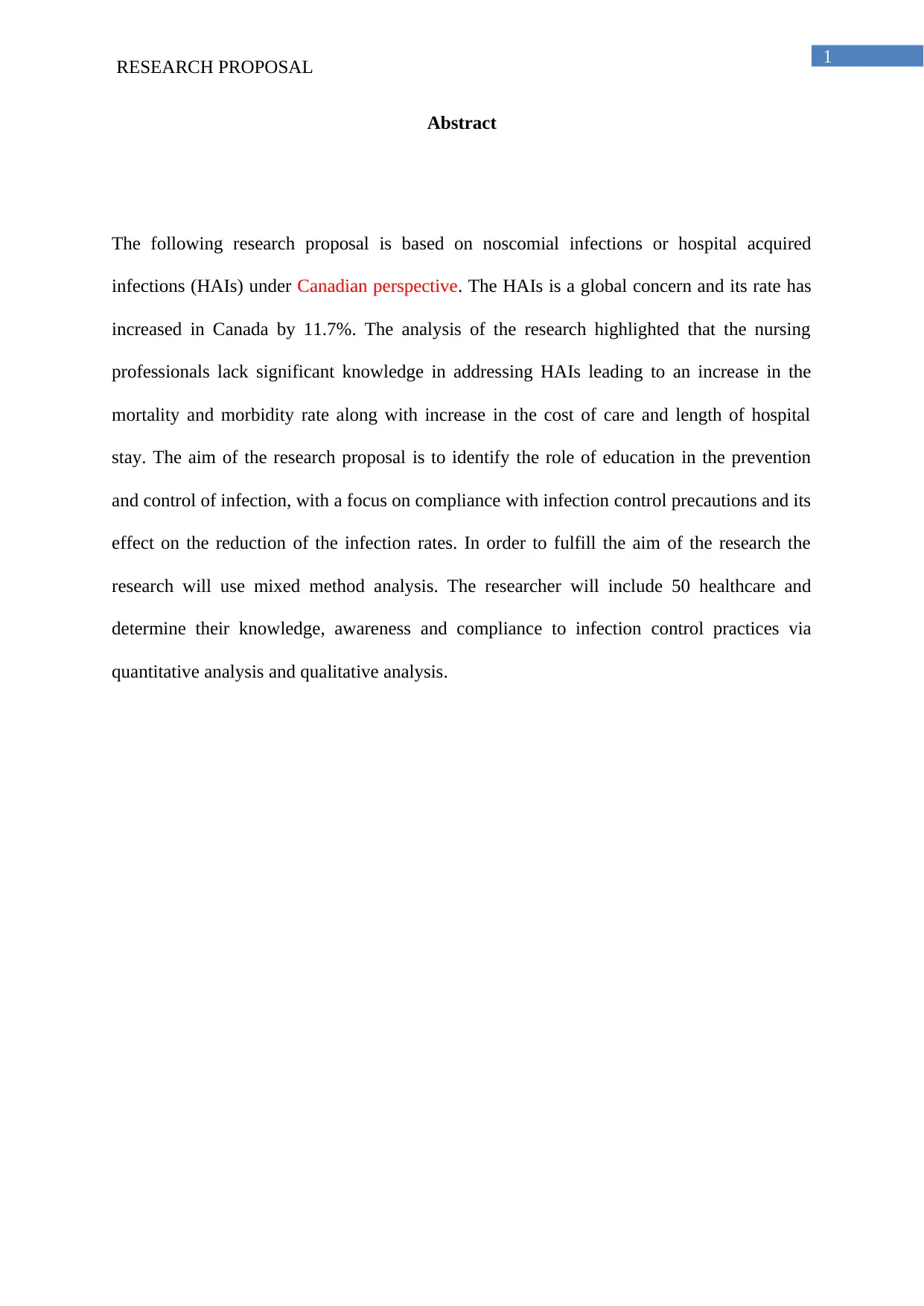
1
RESEARCH PROPOSAL
Abstract
The following research proposal is based on noscomial infections or hospital acquired
infections (HAIs) under Canadian perspective. The HAIs is a global concern and its rate has
increased in Canada by 11.7%. The analysis of the research highlighted that the nursing
professionals lack significant knowledge in addressing HAIs leading to an increase in the
mortality and morbidity rate along with increase in the cost of care and length of hospital
stay. The aim of the research proposal is to identify the role of education in the prevention
and control of infection, with a focus on compliance with infection control precautions and its
effect on the reduction of the infection rates. In order to fulfill the aim of the research the
research will use mixed method analysis. The researcher will include 50 healthcare and
determine their knowledge, awareness and compliance to infection control practices via
quantitative analysis and qualitative analysis.
RESEARCH PROPOSAL
Abstract
The following research proposal is based on noscomial infections or hospital acquired
infections (HAIs) under Canadian perspective. The HAIs is a global concern and its rate has
increased in Canada by 11.7%. The analysis of the research highlighted that the nursing
professionals lack significant knowledge in addressing HAIs leading to an increase in the
mortality and morbidity rate along with increase in the cost of care and length of hospital
stay. The aim of the research proposal is to identify the role of education in the prevention
and control of infection, with a focus on compliance with infection control precautions and its
effect on the reduction of the infection rates. In order to fulfill the aim of the research the
research will use mixed method analysis. The researcher will include 50 healthcare and
determine their knowledge, awareness and compliance to infection control practices via
quantitative analysis and qualitative analysis.
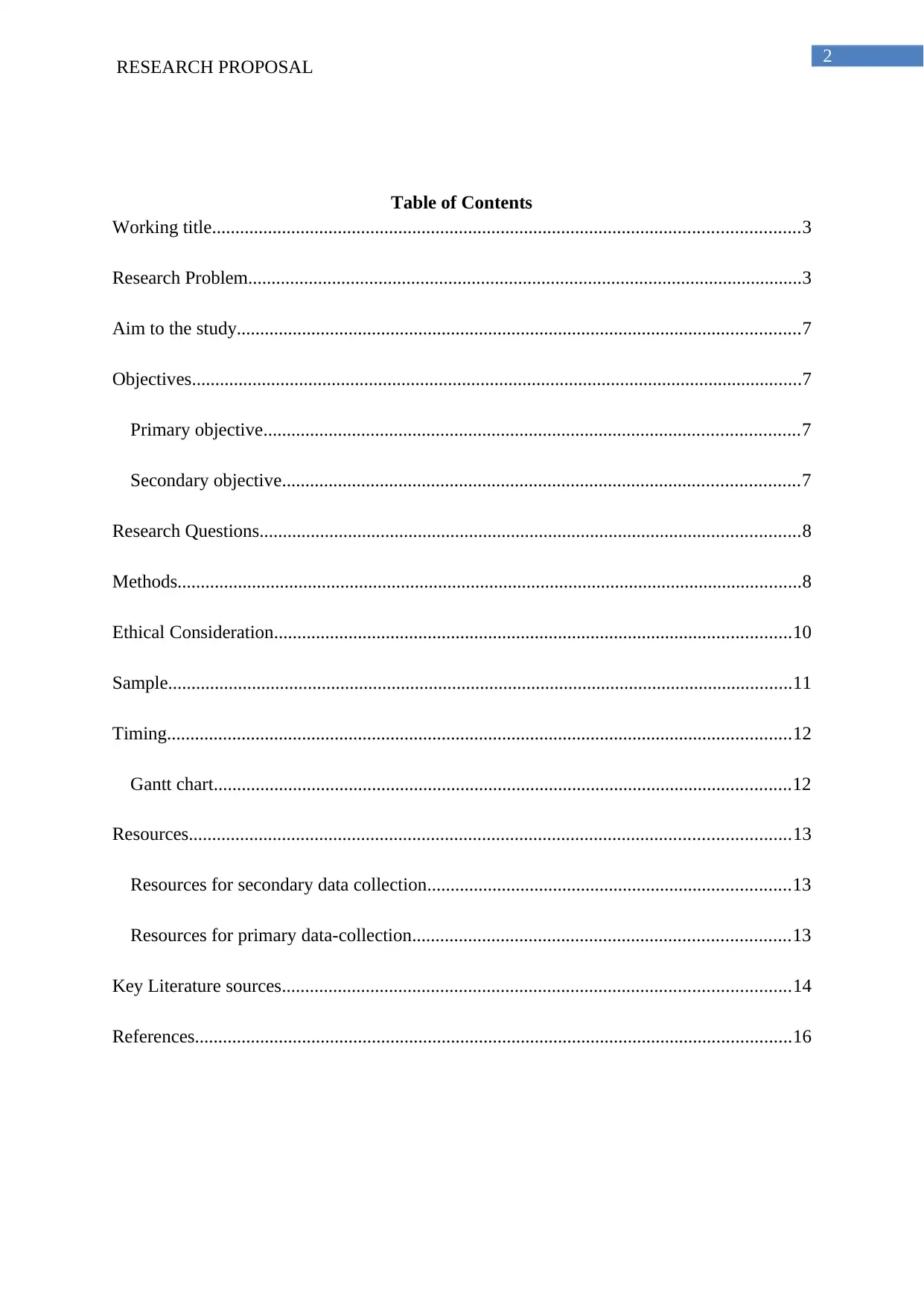
2
RESEARCH PROPOSAL
Table of Contents
Working title..............................................................................................................................3
Research Problem.......................................................................................................................3
Aim to the study.........................................................................................................................7
Objectives...................................................................................................................................7
Primary objective...................................................................................................................7
Secondary objective...............................................................................................................7
Research Questions....................................................................................................................8
Methods......................................................................................................................................8
Ethical Consideration...............................................................................................................10
Sample......................................................................................................................................11
Timing......................................................................................................................................12
Gantt chart............................................................................................................................12
Resources.................................................................................................................................13
Resources for secondary data collection..............................................................................13
Resources for primary data-collection.................................................................................13
Key Literature sources.............................................................................................................14
References................................................................................................................................16
RESEARCH PROPOSAL
Table of Contents
Working title..............................................................................................................................3
Research Problem.......................................................................................................................3
Aim to the study.........................................................................................................................7
Objectives...................................................................................................................................7
Primary objective...................................................................................................................7
Secondary objective...............................................................................................................7
Research Questions....................................................................................................................8
Methods......................................................................................................................................8
Ethical Consideration...............................................................................................................10
Sample......................................................................................................................................11
Timing......................................................................................................................................12
Gantt chart............................................................................................................................12
Resources.................................................................................................................................13
Resources for secondary data collection..............................................................................13
Resources for primary data-collection.................................................................................13
Key Literature sources.............................................................................................................14
References................................................................................................................................16
⊘ This is a preview!⊘
Do you want full access?
Subscribe today to unlock all pages.

Trusted by 1+ million students worldwide
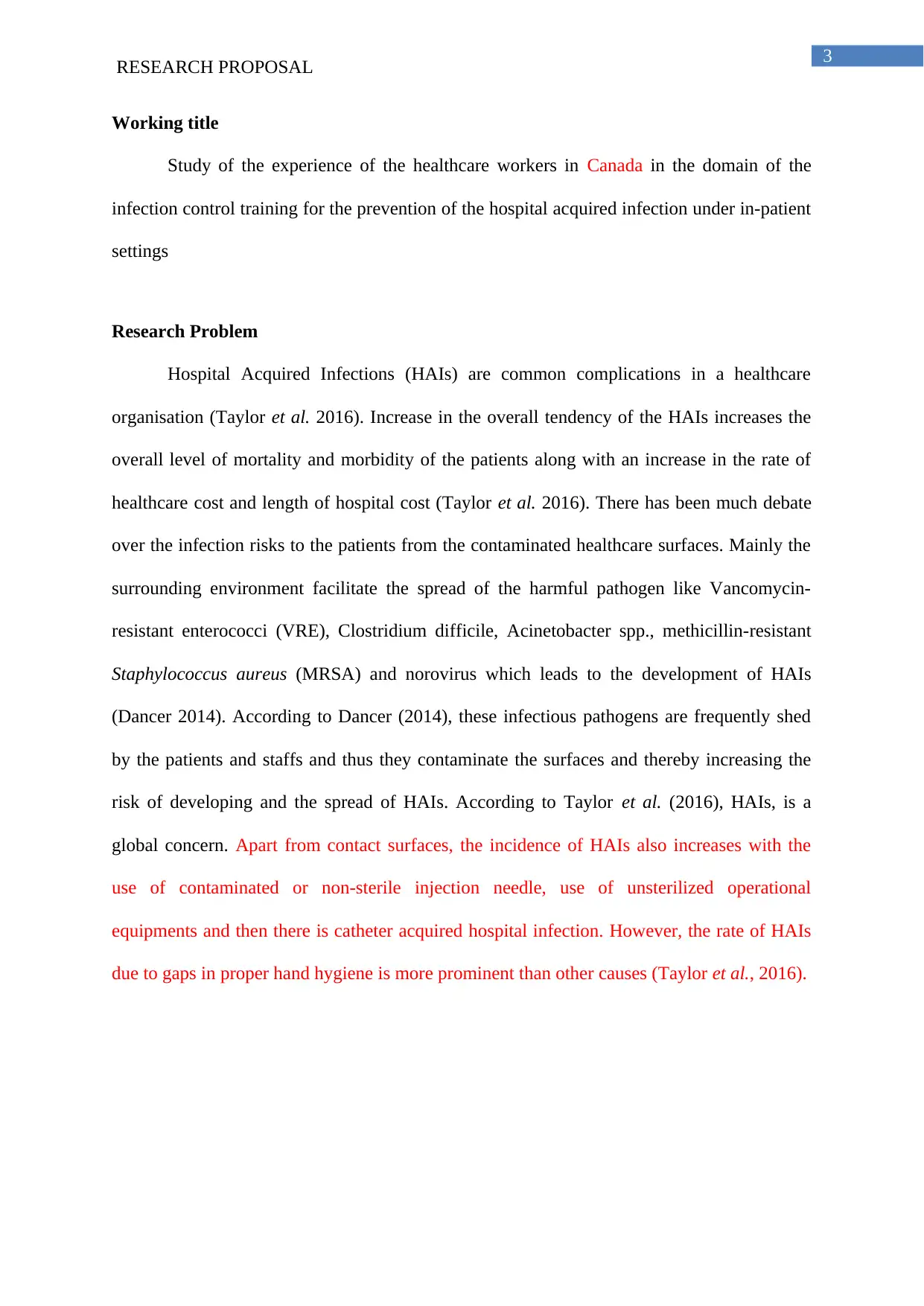
3
RESEARCH PROPOSAL
Working title
Study of the experience of the healthcare workers in Canada in the domain of the
infection control training for the prevention of the hospital acquired infection under in-patient
settings
Research Problem
Hospital Acquired Infections (HAIs) are common complications in a healthcare
organisation (Taylor et al. 2016). Increase in the overall tendency of the HAIs increases the
overall level of mortality and morbidity of the patients along with an increase in the rate of
healthcare cost and length of hospital cost (Taylor et al. 2016). There has been much debate
over the infection risks to the patients from the contaminated healthcare surfaces. Mainly the
surrounding environment facilitate the spread of the harmful pathogen like Vancomycin-
resistant enterococci (VRE), Clostridium difficile, Acinetobacter spp., methicillin-resistant
Staphylococcus aureus (MRSA) and norovirus which leads to the development of HAIs
(Dancer 2014). According to Dancer (2014), these infectious pathogens are frequently shed
by the patients and staffs and thus they contaminate the surfaces and thereby increasing the
risk of developing and the spread of HAIs. According to Taylor et al. (2016), HAIs, is a
global concern. Apart from contact surfaces, the incidence of HAIs also increases with the
use of contaminated or non-sterile injection needle, use of unsterilized operational
equipments and then there is catheter acquired hospital infection. However, the rate of HAIs
due to gaps in proper hand hygiene is more prominent than other causes (Taylor et al., 2016).
RESEARCH PROPOSAL
Working title
Study of the experience of the healthcare workers in Canada in the domain of the
infection control training for the prevention of the hospital acquired infection under in-patient
settings
Research Problem
Hospital Acquired Infections (HAIs) are common complications in a healthcare
organisation (Taylor et al. 2016). Increase in the overall tendency of the HAIs increases the
overall level of mortality and morbidity of the patients along with an increase in the rate of
healthcare cost and length of hospital cost (Taylor et al. 2016). There has been much debate
over the infection risks to the patients from the contaminated healthcare surfaces. Mainly the
surrounding environment facilitate the spread of the harmful pathogen like Vancomycin-
resistant enterococci (VRE), Clostridium difficile, Acinetobacter spp., methicillin-resistant
Staphylococcus aureus (MRSA) and norovirus which leads to the development of HAIs
(Dancer 2014). According to Dancer (2014), these infectious pathogens are frequently shed
by the patients and staffs and thus they contaminate the surfaces and thereby increasing the
risk of developing and the spread of HAIs. According to Taylor et al. (2016), HAIs, is a
global concern. Apart from contact surfaces, the incidence of HAIs also increases with the
use of contaminated or non-sterile injection needle, use of unsterilized operational
equipments and then there is catheter acquired hospital infection. However, the rate of HAIs
due to gaps in proper hand hygiene is more prominent than other causes (Taylor et al., 2016).
Paraphrase This Document
Need a fresh take? Get an instant paraphrase of this document with our AI Paraphraser

4
RESEARCH PROPOSAL
Figure: Statistics of Hospital Acquired Infection in USA
Source: Centre of Disease Development (2018)
According to the Canadian Nosocomial Infection Surveillance Program (CNISP)
there is an increase in the prevalence of the HAIs in Canadian urban teaching hospitals and
the percentage has increases by 11.7% during the tenure of 2002 to 2009. However, statistics
reported by the Department of Health and Community Service Canada (2013), there is an
decrease in the rate of incidence of MRSA infection in Canadian hospital during the tenure of
2009 to 2012 but the incidence rate is still alarming.
RESEARCH PROPOSAL
Figure: Statistics of Hospital Acquired Infection in USA
Source: Centre of Disease Development (2018)
According to the Canadian Nosocomial Infection Surveillance Program (CNISP)
there is an increase in the prevalence of the HAIs in Canadian urban teaching hospitals and
the percentage has increases by 11.7% during the tenure of 2002 to 2009. However, statistics
reported by the Department of Health and Community Service Canada (2013), there is an
decrease in the rate of incidence of MRSA infection in Canadian hospital during the tenure of
2009 to 2012 but the incidence rate is still alarming.
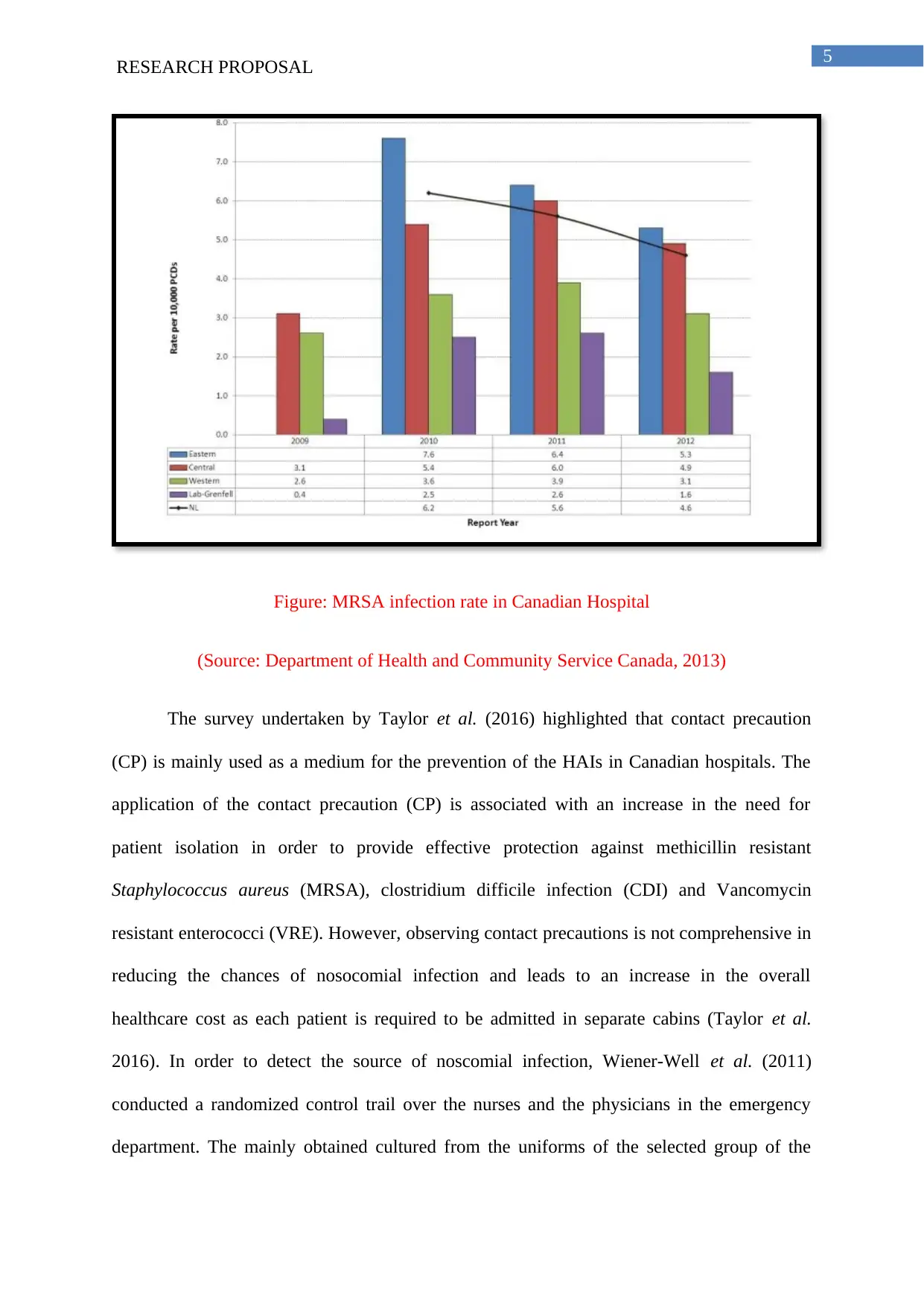
5
RESEARCH PROPOSAL
Figure: MRSA infection rate in Canadian Hospital
(Source: Department of Health and Community Service Canada, 2013)
The survey undertaken by Taylor et al. (2016) highlighted that contact precaution
(CP) is mainly used as a medium for the prevention of the HAIs in Canadian hospitals. The
application of the contact precaution (CP) is associated with an increase in the need for
patient isolation in order to provide effective protection against methicillin resistant
Staphylococcus aureus (MRSA), clostridium difficile infection (CDI) and Vancomycin
resistant enterococci (VRE). However, observing contact precautions is not comprehensive in
reducing the chances of nosocomial infection and leads to an increase in the overall
healthcare cost as each patient is required to be admitted in separate cabins (Taylor et al.
2016). In order to detect the source of noscomial infection, Wiener-Well et al. (2011)
conducted a randomized control trail over the nurses and the physicians in the emergency
department. The mainly obtained cultured from the uniforms of the selected group of the
RESEARCH PROPOSAL
Figure: MRSA infection rate in Canadian Hospital
(Source: Department of Health and Community Service Canada, 2013)
The survey undertaken by Taylor et al. (2016) highlighted that contact precaution
(CP) is mainly used as a medium for the prevention of the HAIs in Canadian hospitals. The
application of the contact precaution (CP) is associated with an increase in the need for
patient isolation in order to provide effective protection against methicillin resistant
Staphylococcus aureus (MRSA), clostridium difficile infection (CDI) and Vancomycin
resistant enterococci (VRE). However, observing contact precautions is not comprehensive in
reducing the chances of nosocomial infection and leads to an increase in the overall
healthcare cost as each patient is required to be admitted in separate cabins (Taylor et al.
2016). In order to detect the source of noscomial infection, Wiener-Well et al. (2011)
conducted a randomized control trail over the nurses and the physicians in the emergency
department. The mainly obtained cultured from the uniforms of the selected group of the
⊘ This is a preview!⊘
Do you want full access?
Subscribe today to unlock all pages.

Trusted by 1+ million students worldwide
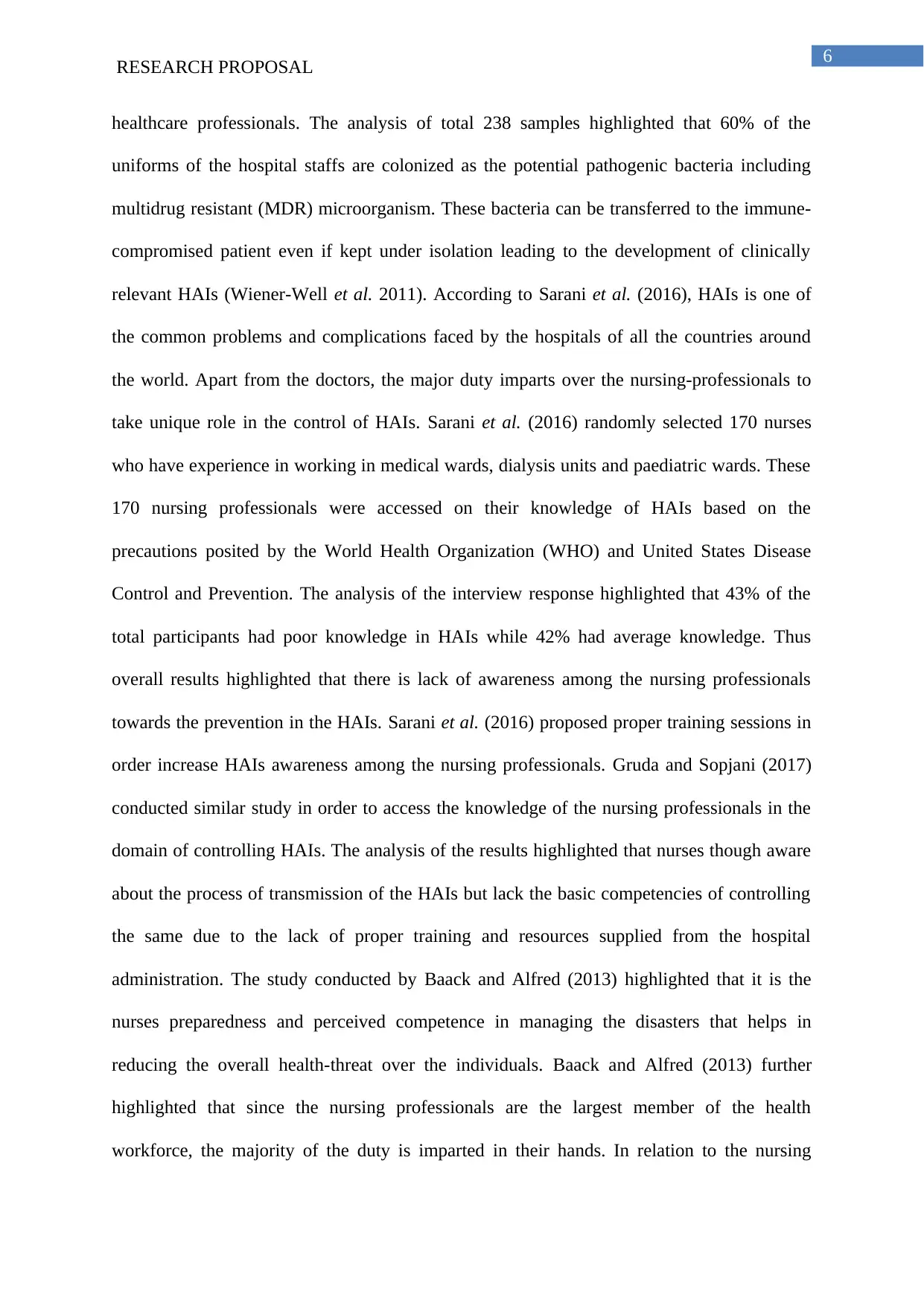
6
RESEARCH PROPOSAL
healthcare professionals. The analysis of total 238 samples highlighted that 60% of the
uniforms of the hospital staffs are colonized as the potential pathogenic bacteria including
multidrug resistant (MDR) microorganism. These bacteria can be transferred to the immune-
compromised patient even if kept under isolation leading to the development of clinically
relevant HAIs (Wiener-Well et al. 2011). According to Sarani et al. (2016), HAIs is one of
the common problems and complications faced by the hospitals of all the countries around
the world. Apart from the doctors, the major duty imparts over the nursing-professionals to
take unique role in the control of HAIs. Sarani et al. (2016) randomly selected 170 nurses
who have experience in working in medical wards, dialysis units and paediatric wards. These
170 nursing professionals were accessed on their knowledge of HAIs based on the
precautions posited by the World Health Organization (WHO) and United States Disease
Control and Prevention. The analysis of the interview response highlighted that 43% of the
total participants had poor knowledge in HAIs while 42% had average knowledge. Thus
overall results highlighted that there is lack of awareness among the nursing professionals
towards the prevention in the HAIs. Sarani et al. (2016) proposed proper training sessions in
order increase HAIs awareness among the nursing professionals. Gruda and Sopjani (2017)
conducted similar study in order to access the knowledge of the nursing professionals in the
domain of controlling HAIs. The analysis of the results highlighted that nurses though aware
about the process of transmission of the HAIs but lack the basic competencies of controlling
the same due to the lack of proper training and resources supplied from the hospital
administration. The study conducted by Baack and Alfred (2013) highlighted that it is the
nurses preparedness and perceived competence in managing the disasters that helps in
reducing the overall health-threat over the individuals. Baack and Alfred (2013) further
highlighted that since the nursing professionals are the largest member of the health
workforce, the majority of the duty is imparted in their hands. In relation to the nursing
RESEARCH PROPOSAL
healthcare professionals. The analysis of total 238 samples highlighted that 60% of the
uniforms of the hospital staffs are colonized as the potential pathogenic bacteria including
multidrug resistant (MDR) microorganism. These bacteria can be transferred to the immune-
compromised patient even if kept under isolation leading to the development of clinically
relevant HAIs (Wiener-Well et al. 2011). According to Sarani et al. (2016), HAIs is one of
the common problems and complications faced by the hospitals of all the countries around
the world. Apart from the doctors, the major duty imparts over the nursing-professionals to
take unique role in the control of HAIs. Sarani et al. (2016) randomly selected 170 nurses
who have experience in working in medical wards, dialysis units and paediatric wards. These
170 nursing professionals were accessed on their knowledge of HAIs based on the
precautions posited by the World Health Organization (WHO) and United States Disease
Control and Prevention. The analysis of the interview response highlighted that 43% of the
total participants had poor knowledge in HAIs while 42% had average knowledge. Thus
overall results highlighted that there is lack of awareness among the nursing professionals
towards the prevention in the HAIs. Sarani et al. (2016) proposed proper training sessions in
order increase HAIs awareness among the nursing professionals. Gruda and Sopjani (2017)
conducted similar study in order to access the knowledge of the nursing professionals in the
domain of controlling HAIs. The analysis of the results highlighted that nurses though aware
about the process of transmission of the HAIs but lack the basic competencies of controlling
the same due to the lack of proper training and resources supplied from the hospital
administration. The study conducted by Baack and Alfred (2013) highlighted that it is the
nurses preparedness and perceived competence in managing the disasters that helps in
reducing the overall health-threat over the individuals. Baack and Alfred (2013) further
highlighted that since the nursing professionals are the largest member of the health
workforce, the majority of the duty is imparted in their hands. In relation to the nursing
Paraphrase This Document
Need a fresh take? Get an instant paraphrase of this document with our AI Paraphraser
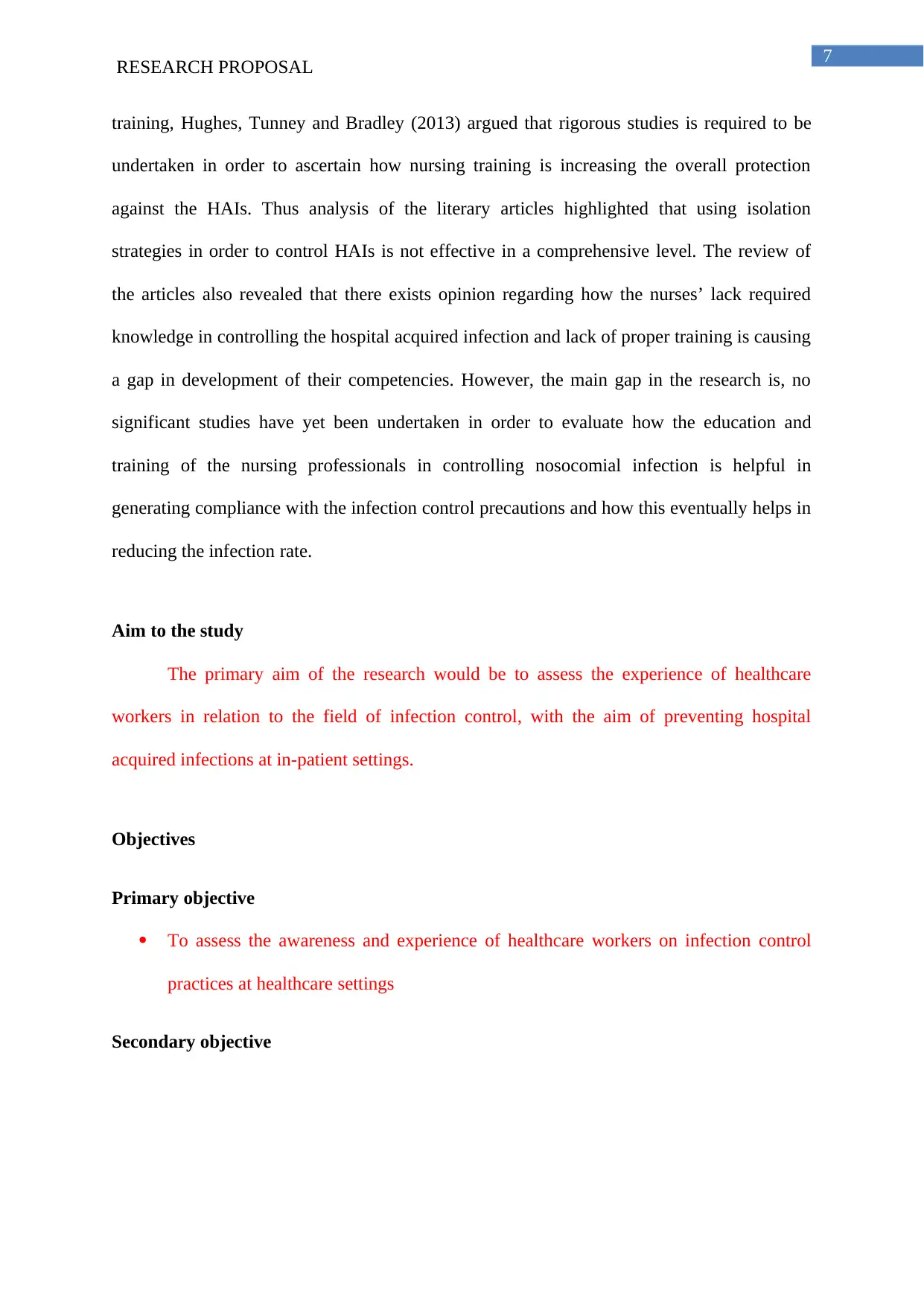
7
RESEARCH PROPOSAL
training, Hughes, Tunney and Bradley (2013) argued that rigorous studies is required to be
undertaken in order to ascertain how nursing training is increasing the overall protection
against the HAIs. Thus analysis of the literary articles highlighted that using isolation
strategies in order to control HAIs is not effective in a comprehensive level. The review of
the articles also revealed that there exists opinion regarding how the nurses’ lack required
knowledge in controlling the hospital acquired infection and lack of proper training is causing
a gap in development of their competencies. However, the main gap in the research is, no
significant studies have yet been undertaken in order to evaluate how the education and
training of the nursing professionals in controlling nosocomial infection is helpful in
generating compliance with the infection control precautions and how this eventually helps in
reducing the infection rate.
Aim to the study
The primary aim of the research would be to assess the experience of healthcare
workers in relation to the field of infection control, with the aim of preventing hospital
acquired infections at in-patient settings.
Objectives
Primary objective
To assess the awareness and experience of healthcare workers on infection control
practices at healthcare settings
Secondary objective
RESEARCH PROPOSAL
training, Hughes, Tunney and Bradley (2013) argued that rigorous studies is required to be
undertaken in order to ascertain how nursing training is increasing the overall protection
against the HAIs. Thus analysis of the literary articles highlighted that using isolation
strategies in order to control HAIs is not effective in a comprehensive level. The review of
the articles also revealed that there exists opinion regarding how the nurses’ lack required
knowledge in controlling the hospital acquired infection and lack of proper training is causing
a gap in development of their competencies. However, the main gap in the research is, no
significant studies have yet been undertaken in order to evaluate how the education and
training of the nursing professionals in controlling nosocomial infection is helpful in
generating compliance with the infection control precautions and how this eventually helps in
reducing the infection rate.
Aim to the study
The primary aim of the research would be to assess the experience of healthcare
workers in relation to the field of infection control, with the aim of preventing hospital
acquired infections at in-patient settings.
Objectives
Primary objective
To assess the awareness and experience of healthcare workers on infection control
practices at healthcare settings
Secondary objective
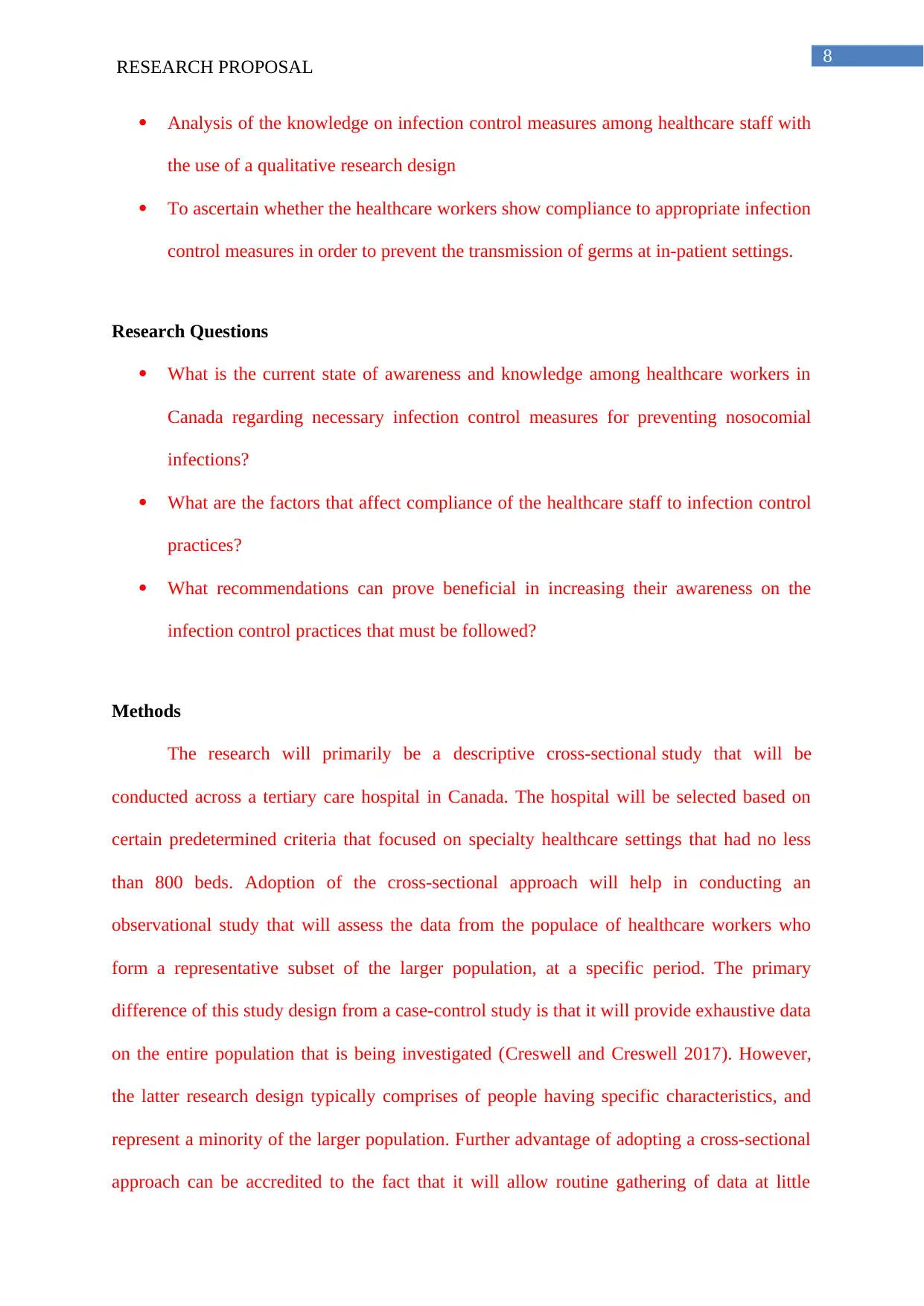
8
RESEARCH PROPOSAL
Analysis of the knowledge on infection control measures among healthcare staff with
the use of a qualitative research design
To ascertain whether the healthcare workers show compliance to appropriate infection
control measures in order to prevent the transmission of germs at in-patient settings.
Research Questions
What is the current state of awareness and knowledge among healthcare workers in
Canada regarding necessary infection control measures for preventing nosocomial
infections?
What are the factors that affect compliance of the healthcare staff to infection control
practices?
What recommendations can prove beneficial in increasing their awareness on the
infection control practices that must be followed?
Methods
The research will primarily be a descriptive cross-sectional study that will be
conducted across a tertiary care hospital in Canada. The hospital will be selected based on
certain predetermined criteria that focused on specialty healthcare settings that had no less
than 800 beds. Adoption of the cross-sectional approach will help in conducting an
observational study that will assess the data from the populace of healthcare workers who
form a representative subset of the larger population, at a specific period. The primary
difference of this study design from a case-control study is that it will provide exhaustive data
on the entire population that is being investigated (Creswell and Creswell 2017). However,
the latter research design typically comprises of people having specific characteristics, and
represent a minority of the larger population. Further advantage of adopting a cross-sectional
approach can be accredited to the fact that it will allow routine gathering of data at little
RESEARCH PROPOSAL
Analysis of the knowledge on infection control measures among healthcare staff with
the use of a qualitative research design
To ascertain whether the healthcare workers show compliance to appropriate infection
control measures in order to prevent the transmission of germs at in-patient settings.
Research Questions
What is the current state of awareness and knowledge among healthcare workers in
Canada regarding necessary infection control measures for preventing nosocomial
infections?
What are the factors that affect compliance of the healthcare staff to infection control
practices?
What recommendations can prove beneficial in increasing their awareness on the
infection control practices that must be followed?
Methods
The research will primarily be a descriptive cross-sectional study that will be
conducted across a tertiary care hospital in Canada. The hospital will be selected based on
certain predetermined criteria that focused on specialty healthcare settings that had no less
than 800 beds. Adoption of the cross-sectional approach will help in conducting an
observational study that will assess the data from the populace of healthcare workers who
form a representative subset of the larger population, at a specific period. The primary
difference of this study design from a case-control study is that it will provide exhaustive data
on the entire population that is being investigated (Creswell and Creswell 2017). However,
the latter research design typically comprises of people having specific characteristics, and
represent a minority of the larger population. Further advantage of adopting a cross-sectional
approach can be accredited to the fact that it will allow routine gathering of data at little
⊘ This is a preview!⊘
Do you want full access?
Subscribe today to unlock all pages.

Trusted by 1+ million students worldwide

9
RESEARCH PROPOSAL
expense (Meyers, Gamst and Guarino 2016). The research was intended to be conducted
across a tertiary hospital in Canada since it allowed the selection of sample from a larger
population that was close to hand.
A mixed method approach will be undertaken for the same. The process of data
collection will be facilitated by the distribution of a structured and self-administered
questionnaires, and conduction of interviews (Creswell and Clark 2017). This research design
primarily comprises of collection, analysis and integration of qualitative (interviews, focus
group) and quantitative (experiments, surveys) research. The use of this method over other
process can be attributed to the role of mixed-method procedure in facilitating gaining an in-
depth understanding and validation of collection data, while counterweighing the flaws
inherent to each approach (Lewis 2015). This will create the possibility of triangulation that
will allow identification of different aspects of a particular phenomenon in an accurate
manner from a range of points, using varied techniques and methods.
Questionnaires have been recognised as ideal data collection tools since the research
instruments allow collection of feedback from several individuals and does not require the
use of any other resource intensive method. This data collection tool is typically of two kinds
namely, structured and unstructured. However, structured questionnaires will be used for the
research where closed questions that will produce data that can be assessed quantitatively.
Owing to the fact that each response will be assigned a value that can be easily interpreted via
statistical analysis (Weigold, Weigold and Russell 2013). Furthermore, open-ended questions
will not be framed in the questionnaire due to the associated difficulty in comparing the
connotation of the responses. The questionnaires will focus on different aspects related to
standard precautions, knowledge on hand hygiene, compliance reporting, and PPE use,
besides demographic variables. The SPSS 21.0 version software will be used for assessing
the data entered in the questionnaire. Independent t test will be used for exploring differences
RESEARCH PROPOSAL
expense (Meyers, Gamst and Guarino 2016). The research was intended to be conducted
across a tertiary hospital in Canada since it allowed the selection of sample from a larger
population that was close to hand.
A mixed method approach will be undertaken for the same. The process of data
collection will be facilitated by the distribution of a structured and self-administered
questionnaires, and conduction of interviews (Creswell and Clark 2017). This research design
primarily comprises of collection, analysis and integration of qualitative (interviews, focus
group) and quantitative (experiments, surveys) research. The use of this method over other
process can be attributed to the role of mixed-method procedure in facilitating gaining an in-
depth understanding and validation of collection data, while counterweighing the flaws
inherent to each approach (Lewis 2015). This will create the possibility of triangulation that
will allow identification of different aspects of a particular phenomenon in an accurate
manner from a range of points, using varied techniques and methods.
Questionnaires have been recognised as ideal data collection tools since the research
instruments allow collection of feedback from several individuals and does not require the
use of any other resource intensive method. This data collection tool is typically of two kinds
namely, structured and unstructured. However, structured questionnaires will be used for the
research where closed questions that will produce data that can be assessed quantitatively.
Owing to the fact that each response will be assigned a value that can be easily interpreted via
statistical analysis (Weigold, Weigold and Russell 2013). Furthermore, open-ended questions
will not be framed in the questionnaire due to the associated difficulty in comparing the
connotation of the responses. The questionnaires will focus on different aspects related to
standard precautions, knowledge on hand hygiene, compliance reporting, and PPE use,
besides demographic variables. The SPSS 21.0 version software will be used for assessing
the data entered in the questionnaire. Independent t test will be used for exploring differences
Paraphrase This Document
Need a fresh take? Get an instant paraphrase of this document with our AI Paraphraser
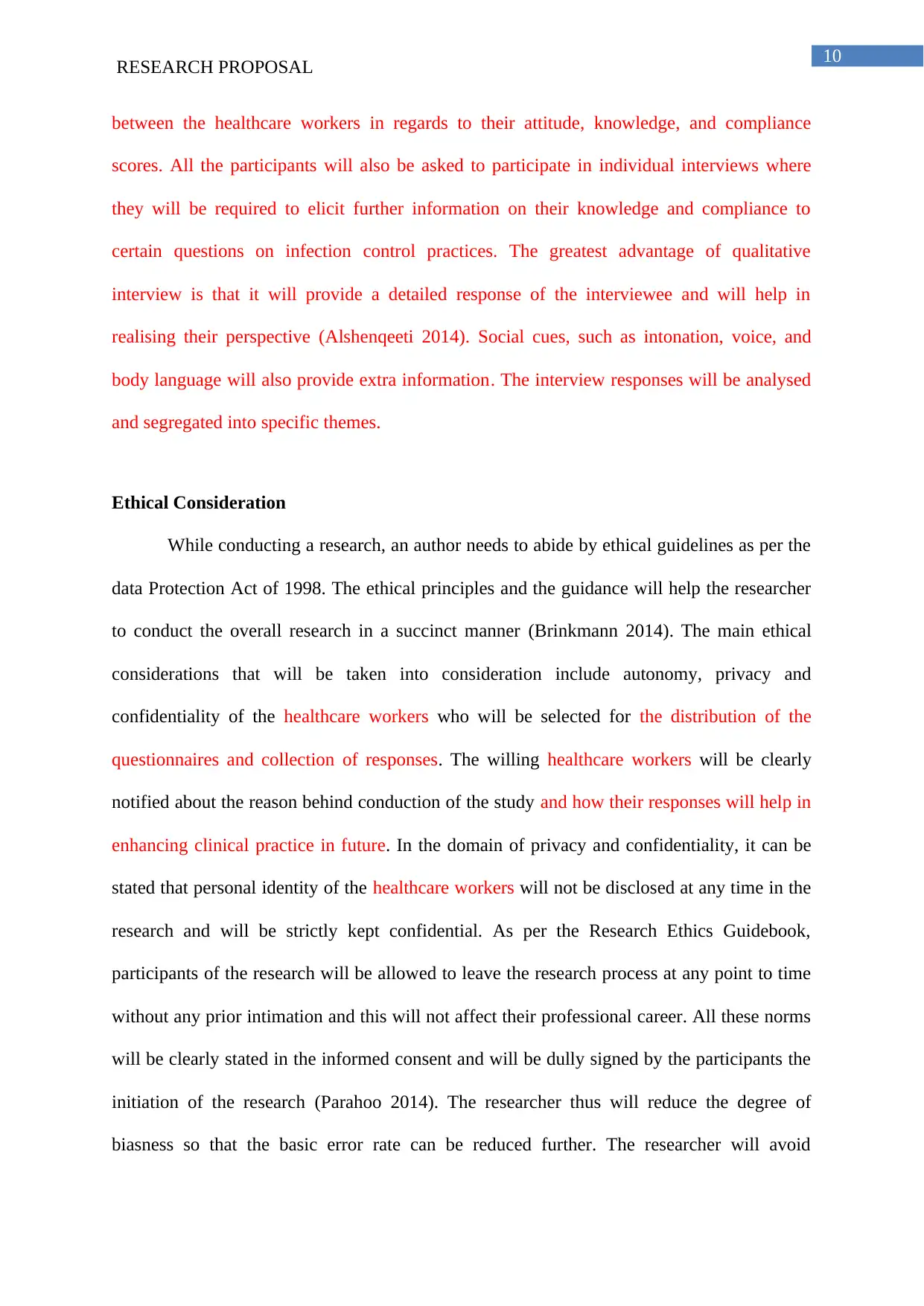
10
RESEARCH PROPOSAL
between the healthcare workers in regards to their attitude, knowledge, and compliance
scores. All the participants will also be asked to participate in individual interviews where
they will be required to elicit further information on their knowledge and compliance to
certain questions on infection control practices. The greatest advantage of qualitative
interview is that it will provide a detailed response of the interviewee and will help in
realising their perspective (Alshenqeeti 2014). Social cues, such as intonation, voice, and
body language will also provide extra information. The interview responses will be analysed
and segregated into specific themes.
Ethical Consideration
While conducting a research, an author needs to abide by ethical guidelines as per the
data Protection Act of 1998. The ethical principles and the guidance will help the researcher
to conduct the overall research in a succinct manner (Brinkmann 2014). The main ethical
considerations that will be taken into consideration include autonomy, privacy and
confidentiality of the healthcare workers who will be selected for the distribution of the
questionnaires and collection of responses. The willing healthcare workers will be clearly
notified about the reason behind conduction of the study and how their responses will help in
enhancing clinical practice in future. In the domain of privacy and confidentiality, it can be
stated that personal identity of the healthcare workers will not be disclosed at any time in the
research and will be strictly kept confidential. As per the Research Ethics Guidebook,
participants of the research will be allowed to leave the research process at any point to time
without any prior intimation and this will not affect their professional career. All these norms
will be clearly stated in the informed consent and will be dully signed by the participants the
initiation of the research (Parahoo 2014). The researcher thus will reduce the degree of
biasness so that the basic error rate can be reduced further. The researcher will avoid
RESEARCH PROPOSAL
between the healthcare workers in regards to their attitude, knowledge, and compliance
scores. All the participants will also be asked to participate in individual interviews where
they will be required to elicit further information on their knowledge and compliance to
certain questions on infection control practices. The greatest advantage of qualitative
interview is that it will provide a detailed response of the interviewee and will help in
realising their perspective (Alshenqeeti 2014). Social cues, such as intonation, voice, and
body language will also provide extra information. The interview responses will be analysed
and segregated into specific themes.
Ethical Consideration
While conducting a research, an author needs to abide by ethical guidelines as per the
data Protection Act of 1998. The ethical principles and the guidance will help the researcher
to conduct the overall research in a succinct manner (Brinkmann 2014). The main ethical
considerations that will be taken into consideration include autonomy, privacy and
confidentiality of the healthcare workers who will be selected for the distribution of the
questionnaires and collection of responses. The willing healthcare workers will be clearly
notified about the reason behind conduction of the study and how their responses will help in
enhancing clinical practice in future. In the domain of privacy and confidentiality, it can be
stated that personal identity of the healthcare workers will not be disclosed at any time in the
research and will be strictly kept confidential. As per the Research Ethics Guidebook,
participants of the research will be allowed to leave the research process at any point to time
without any prior intimation and this will not affect their professional career. All these norms
will be clearly stated in the informed consent and will be dully signed by the participants the
initiation of the research (Parahoo 2014). The researcher thus will reduce the degree of
biasness so that the basic error rate can be reduced further. The researcher will avoid

11
RESEARCH PROPOSAL
manipulation of data or alteration of the data so that the work remains authentic (Parahoo
2014).
Sample
Sampling refers to the procedure that involves the selection of a representative group
from a larger population that is being investigated. Hence, the target population comprises of
the entire group of people from which the sample will be directly recruited. The different
types of sampling that are commonly utilised for research are probability and non-probability
samples. While each element of the population holds a non-zero chance of getting selected
for the research in probability samples, the same is not known for the latter (Uprichard 2013).
A total of 50 staff will be recruited from the hospital to participate in the research. This
particular research will be based on convenience sampling. This process is a kind of non-
probability sampling where the sample of healthcare workers will be recruited from the group
of individuals who can be easily reached or accessed (the tertiary hospital in Canada) (Etikan,
Musa and Alkassim 2016). Eligible participants will be selected based on a clinical
experience of at least one year in the hospital. Furthermore, they must also be able to
understand English, the language in which the questionnaire will be framed. Administrative
personnel who had bedside duty will also be included in the research. Owing to the fact that
the questionnaire will be internally distributed to the employees of the healthcare
organisation, 30-40% will be considered as a good response rate (Acharya et al. 2013).
Main Criteria for Sampling
Parameter Criteria Rationale
RESEARCH PROPOSAL
manipulation of data or alteration of the data so that the work remains authentic (Parahoo
2014).
Sample
Sampling refers to the procedure that involves the selection of a representative group
from a larger population that is being investigated. Hence, the target population comprises of
the entire group of people from which the sample will be directly recruited. The different
types of sampling that are commonly utilised for research are probability and non-probability
samples. While each element of the population holds a non-zero chance of getting selected
for the research in probability samples, the same is not known for the latter (Uprichard 2013).
A total of 50 staff will be recruited from the hospital to participate in the research. This
particular research will be based on convenience sampling. This process is a kind of non-
probability sampling where the sample of healthcare workers will be recruited from the group
of individuals who can be easily reached or accessed (the tertiary hospital in Canada) (Etikan,
Musa and Alkassim 2016). Eligible participants will be selected based on a clinical
experience of at least one year in the hospital. Furthermore, they must also be able to
understand English, the language in which the questionnaire will be framed. Administrative
personnel who had bedside duty will also be included in the research. Owing to the fact that
the questionnaire will be internally distributed to the employees of the healthcare
organisation, 30-40% will be considered as a good response rate (Acharya et al. 2013).
Main Criteria for Sampling
Parameter Criteria Rationale
⊘ This is a preview!⊘
Do you want full access?
Subscribe today to unlock all pages.

Trusted by 1+ million students worldwide
1 out of 20
Related Documents
Your All-in-One AI-Powered Toolkit for Academic Success.
+13062052269
info@desklib.com
Available 24*7 on WhatsApp / Email
![[object Object]](/_next/static/media/star-bottom.7253800d.svg)
Unlock your academic potential
Copyright © 2020–2026 A2Z Services. All Rights Reserved. Developed and managed by ZUCOL.





